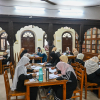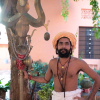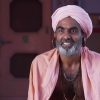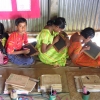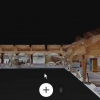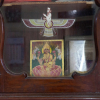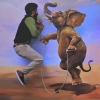G. Sundari: Before it became the Kalakshetra Foundation it was the Besant Cultural Centre and the first institution to be started there was the Besant Memorial High School, because Annie Besant before she died, she told Dr. Arundale, Rukmini Devi’s husband, who was the third President of the Theosophical Society, that she would like a school near Adyar where the children could learn of her and of her love for children, you see. So that school was started in 1934.
Then we had, Rukmini Devi was always interested in dramatics and then dances and other things. So she was producing plays before that. When she was 32 years old, she started learning Bharatanatyam, not an age in which usually they start and she gave performances. The first performance was for the Theosophists in the International Convention at Adyar, in the theatre here…I will take you to that theatre…and there in 1935. I was a child of five watching that performance then, you see. And it gave such an impression it made.
And then there was an Irish poet here, who was quite well known, James Cousins. His wife was also well-known, she was a Congress worker, who had worked with Sarojini Naidu and all that. And this Irish poet, he said, you have revived this dance which was in the custody of Devadasis, the temple dancers, who were betrothed to the temple, you see. So you can better start an education institution and leave a legacy. He almost pestered her into doing it.
And so on January 6th, 1936, she started the Kalakshetra with my sister Leelavati, Ajai Leelavati. She later married Rukmini Devi’s nephew, brother’s son, Sriram’s son, but she was the first student. The second student was Radha Burnier, then she was Radha Sriram, her elder brother is Sriram. She came a couple of years later, after completing her schooling in our school, you see, SSLC [Secondary School Leaving Certificate]. And so, these two used to dance together and they thought the Pandanallur style was the most decent one and so from the lineage, the first professional teacher in Kalakshetra was Muthukumara Pillai. I knew him very well, very lovely man. Usually these nattuvanars, they won’t dance and show, only sit and show but this Muthukumara Pillai used to stand up and dance and do the adavus [exercises] and show. He was [a] very nice person also, a nationalist who came from Kattumanar. He taught a number of folk dances to our children also here. And he used to come home and take practice for Leela[vati] and he used to teach me to make, you know, things with paper. He was very clever, all aeroplane, ship and ink pot, so many other things he used to teach me. Very nice man, I was a child.
And then this Leela and Radha, you see, Rukmini Devi had learnt ballet from Anna Pavlova’s teacher, Cleo Nordi. In ballet what is so important is perception of movement. So she said, ‘I want to improve on this.’ She would take Radha and Leela separately, when the nattuvanars were not there and then made the movements per se. For instance, before they would stretch their hand like this (demonstrates) not fully like this, or when they made a finish at the end of each movement, gives it some polish, you see all this they did not have. But they were clever people. Later on Meenakshi Sundaram Pillai, the doyen of this school, Pandanallur School, he came here to teach. He and his nephew, Meenakshi Sundaram Pillai’s nephew, Chokkalingam Pillai, both of them, they saw how it had improved the thing so they adopted it. They did not mind it, they adopted it. Great persons, they won’t mind changes, changing, it is only people with small feelings they don’t want to change. But they adopted and then they taught several people, many of their pupils including Mrinalini Sarabhai and others, they became very famous and they danced, you see.
And so Leela and Radha used to dance together. When Rukmini Devi performed, she used to change costumes three times, and so when she was changing costume these two used to perform. Radha was very good with adavus, brisk and all that. Leela was very good with expression, abhinaya, you see. So they complemented each other and they used to dance. Later on many pupils came. Few who joined later on who became well-known were, Anjali Mehr, before that Sarada, A. Sarada she was, she became Sarada Hoffman, Paul Hoffman’s daughter-in-law. So these were the early students, many of them. Later on of course we had people from all over like, Yamini Krishnamurthy and then who else did we have, we had Sanjukta Mishra. And Rukmini was very good in teaching the dance to suit the physical body of each dancer. For instance Sanjukta had knock-knees, you see, so she would teach her to suit it that way.
That is how the whole thing started and went on. And then there were great people, Kalki Krishnamurthy, you have heard of him? He was one of the founding members of Kalakshetra, Director Subrahmanyam, Padma Subrahmanyam’s father, and these people, and…TR Venkatarama Iyer, TL Venkatarama Iyer and all. [TK] Chidambaranatha Mudaliar, you know, who was a great Tamil scholar, he used to come here and he told Rukmini, ‘Look, we are doing so many of these temple dance-dramas, kuravanjis. Why don’t you do a kuravanji, at least? And if you polish it and make it, it’ll be so nice.’ And she said, ‘Where is the material?’ He said, ‘No dearth of material, I will get you from my native place, Kuttralam.’ You see they do the kuravanji there. So he brought the verses from Kuttralam, these…what they did, Kuttralam Kuravanji.
That was her first dance-drama and all her dance-dramas, 24 dance-dramas, were edited by Sarada, Periya Sarada. Because she was the granddaughter of you see, Subramania Sastri, who was a scholar of scholars. People from all over the world used to come to Tanjore to consult him. he was well-versed in Alankara Shastra, Natya Shastra and music and dance. And so she was able to edit the music to suit the dance. So…sometimes even great vidwans here, when she was editing, she will send a verse back to them to re-compose, because they didn’t suit the situation, the raga and the way it was composed, it was composed happily. That was how it was done. It was all teamwork. But the dance creation, instantaneous, was done by Rukmini Devi.
The next composition that Rukmini Devi did was Kalidasa’s Kumarasambhavam, music and this chorus that surrounded Rukmini Devi and a helper, who worked from the very beginning with her, my Headmaster, later on Principal, Mr. Shankar Menon—they insisted she compose Kumarasambhavam. And so Sarada with difficulty edited it and Rukmini Devi did the part of Parvati and (K.P.) Kunhiraman that of Shiva and C.V. Chandrasekhar, he was Manmatha in that, you know, shooting a flower arrow on Shiva. He did it so well. And so that was the second composition.
And later on she started composing the Ramayana series. You see, six parts in Ramayana, it took her 14 years to complete. And she always used to joke, ‘Rama went on exile for 14 years, it has taken me 14 years to complete the Ramayana.’ We had some difficulties in the middle and so she couldn’t continue with the composition and also she was a nominated MP in the Rajya Sabha. That is where she introduced the Animal Welfare Bill—they have the Animal Welfare Board because of her, you see. So that is the reason it took such a long time.
And the Ramayana series is all taken only in Sita Swayamvaram, they have taken little bits from other Ramayanas, like the Ananda Ramayana and all. But otherwise the whole lot is from Valmiki Ramayana. And the music for it was composed by (Mysore) Vasudevachar, the first three Ramayanas. And the last there were composed by his grandson S. Rajaram.
That is the way it went on. And later on they had Meenakshi Vijayam and for Tagore’s centenary in the middle she had to compose a dance-drama, the government wanted it, Kamaladevi Chattopadhyay. So she said, ‘Where is the music ready?’ They wanted it within a short time. So for Shyama the music was ready, one Sunil Patro came and taught it to our people. Mani Krishnaswami sang, she is our student you see. So they sang this for Shyama and it was produced by Rukmini Devi.
I used to go about from city to city collecting funds by arranging dance-dramas in place and collecting funds for Kalakshetra. When I was in Calcutta the Shantiniketan people came over and they wanted the compositions, Gurudev’s composition, you see ‘Shyama’ and one Ramayana play. So I arranged for our latest Ramayana, I hadn’t seen it; she has composed ‘Sabari Moksham’ here when I was away in Calcutta and ‘Shyama’ I had seen. So I arranged for both these. She came to Calcutta and she said, ‘Oh, these people will know so much and this ‘Shyama’ will be a failure. I will do another dance-drama. You can’t do’ and all that this. And all the way in the train from Calcutta to Shantiniketan she was after me. But when ‘Shyama’ was staged there, I had arranged for Suchitra Mitra, who is no more, to sing. She was one of the best people who could sing Rabindra Sangeet, you see. So she was singing and Rukmini Devi’s composition. More than 10,000 people were there, open-air theatre in Shantiniketan, they all stood up in the end and the clapping wouldn’t end. But look at Rukmini Devi’s simplicity, she takes the mike and says, ‘Where is Sundari?’ (Laughs)
That is the way she was. That’s why we…though she had an artistic temperament we could work with her like a family, you see. That is the beauty of it.
(G. Sundari was a member of Kalakshetra’s Executive Committee for a number of years and also assistant editor of the Kalakshetra Quarterly. She retired in 1989 and continues to do publicity for the Theosophical Society.)

